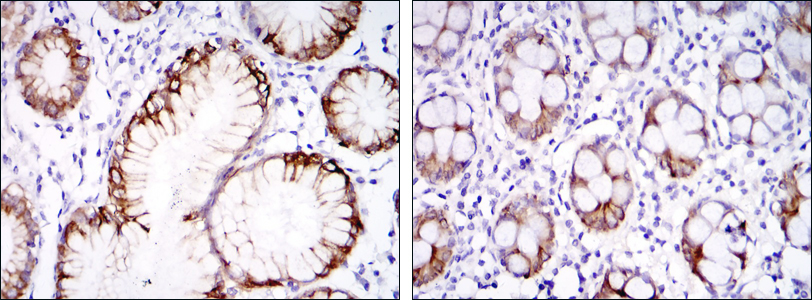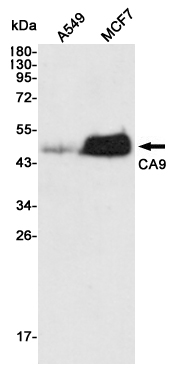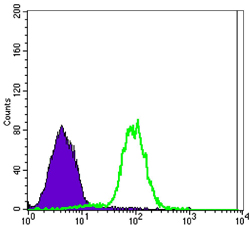-
Product Name
Anti-Carbonic Anhydrase 9/CA9 (5B5) Mouse antibody
- Documents
-
Description
Carbonic Anhydrase 9/CA9 (5B5) Mouse monoclonal antibody
-
Tested applications
WB, IHC-P, FC
-
Species reactivity
Human
-
Isotype
Mouse IgG1
-
Preparation
Antigen: Purified recombinant fragment of human CA9 expressed in E. Coli.
-
Clonality
Monoclonal
-
Formulation
Ascitic fluid containing 0.03% sodium azide.
-
Storage instructions
Store at 4°C short term. Store at -20°C long term. Avoid freeze / thaw cycle.
-
Applications
WB: 1/500 - 1/2000
IHC: 1/200 - 1/1000
FC: 1/200 - 1/400
ELISA: 1/10000
-
Validations

Immunohistochemical analysis of paraffin-embedded stomach tissues (left) and colon tissues (right) using CA9 mouse mAb with DAB staining.

Western blot detection of CA9 in A549 and MCF7 cell lysates using CA9 mouse mAb (1:5000 diluted).Predicted band size:50KDa.Observed band size:50KDa.

Flow cytometric analysis of NTERA-2 cells using CA9 mouse mAb (green) and negative control (purple).
-
Background
Swiss-Prot Acc.Q16790.CA IX is a transmembrane protein and the only tumor-associated carbonic anhydrase isoenzyme known. It is expressed in all clear-cell renal cell carcinoma, but is not detected in normal kidney or most other normal tissues. It may be involved in cell proliferation and transformation. Reversible hydration of carbon dioxide. Participates in pH regulation. May be involved in the control of cell proliferation and transformation. Appears to be a novel specific biomarker for a cervical neoplasia. Tissue specificity: Expressed primarily in carcinoma cells lines. Expression is restricted to very few normal tissues and the most abundant expression is found in the epithelial cells of gastric mucosa.
Related Products / Services
Please note: All products are "FOR RESEARCH USE ONLY AND ARE NOT INTENDED FOR DIAGNOSTIC OR THERAPEUTIC USE"
